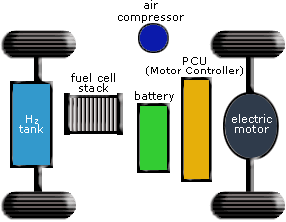What is a fuel cell vehicle?
Fuel cell vehicles use a completely different propulsion system than conventional vehicles, which can be two to three times more efficient. Unlike conventional vehicles, they produce no harmful exhaust emissions—their only emission is water. Other benefits include increasing U.S. energy security and strengthening the economy.
Fuel cell vehicles are fueled with hydrogen, which is considered an alternative fuel under the Energy Policy Act of 1992 and qualifies for alternative fuel vehicle tax credits.
Fuel cell vehicles are still at an early stage of development. Research and development efforts are bringing them closer to commercialization.
How Fuel Cell Vehicles Work

This Hydrogen, Fuel Cells and Infrastructure Technologies Program animation shows how polymer electrolyte membrane (PEM) fuel cells work.
Like electric vehicles, fuel cell vehicles use electricity to power motors located near the vehicle's wheels. In contrast to electric vehicles, fuel cell vehicles produce their primary electricity using a fuel cell. The fuel cell is powered by filling the fuel tank with hydrogen.
The most common type of fuel cell for vehicle applications is the polymer electrolyte membrane (PEM) fuel cell. In a PEM fuel cell, an electrolyte membrane is sandwiched between a positive electrode (cathode) and a negative electrode (anode). Hydrogen is introduced to the anode and oxygen to the cathode. The hydrogen molecules travel through the membrane to the cathode but not before the membrane strips the electrons off the hydrogen molecules.
The electrons are forced to travel through an external circuit to recombine with the hydrogen ions on the cathode side, where the hydrogen ions, electrons, and oxygen molecules combine to form water. The flow of electrons through the external circuit forms the electrical current needed to power a vehicle. See an animation of the process.
Fuel cell vehicles can be fueled with pure hydrogen gas stored directly on the vehicle or extracted from a secondary fuel—such as methanol, ethanol, or natural gas—that carries hydrogen. These secondary fuels must first be converted into hydrogen gas by an onboard device called a reformer. Fuel cell vehicles fueled with pure hydrogen emit no pollutants, only water and heat. Vehicles that use secondary fuels and a reformer produce only small amounts of air pollutants.
Fuel cell vehicles can be equipped with other advanced technologies to increase efficiency, such as regenerative braking systems, which capture the energy lost during braking and store it in a large battery.

Schematic of a fuel cell vehicle (Source: NREL)
Fuel Cell Vehicle and Infrastructure Development
Because fuel cell vehicles require a completely new vehicle propulsion system and new fueling infrastructure, many deployment issues can only be addressed by integrating and evaluating the components in complete systems. The U.S. Department of Energy (DOE) is developing and testing complete system solutions that address all elements of infrastructure and vehicle technology, validating integrated hydrogen and fuel cell technologies for transportation, infrastructure, and electric generation in a systems context under real-world operating conditions. See the DOE Hydrogen, Fuel Cells and Infrastructure Technologies Program Technology Validation and National Renewable Energy Laboratory Hydrogen Technology Validation pages.
U.S. Hydrogen Transportation Demonstrations
- DOE National Hydrogen Learning Demonstration
- Hydrogen Fuel Cell Bus Evaluation for California Transit Agencies
- Integrated Projects (includes domestic and international projects)
- Hydrogen Internal Combustion Engine Vehicles
International Hydrogen Transportation Demonstrations
Also learn about the vehicle technologies being developed by DOE's Vehicle Technologies Program.

